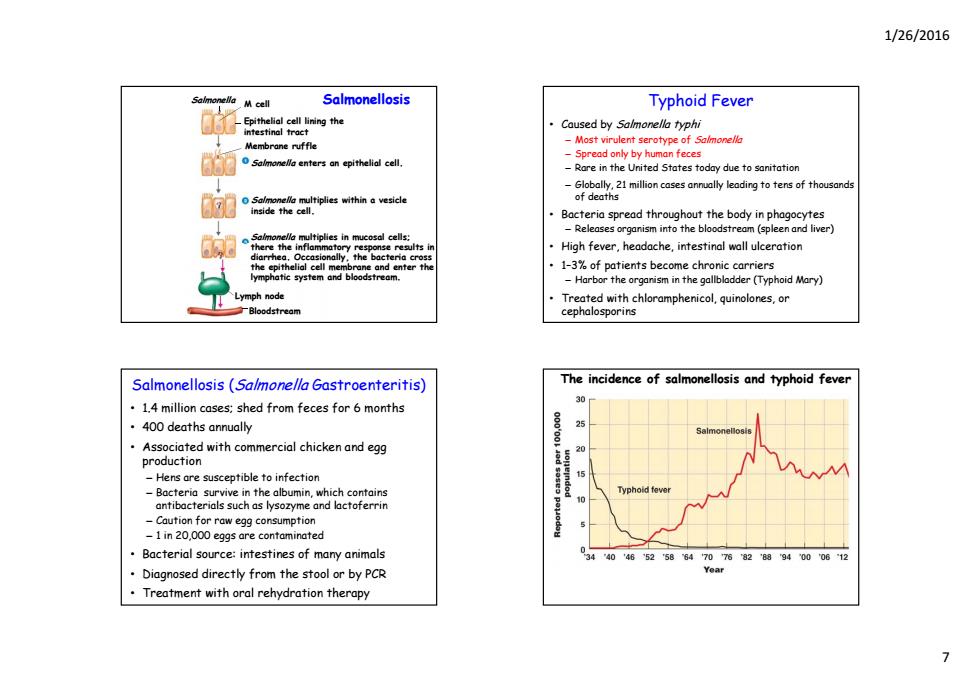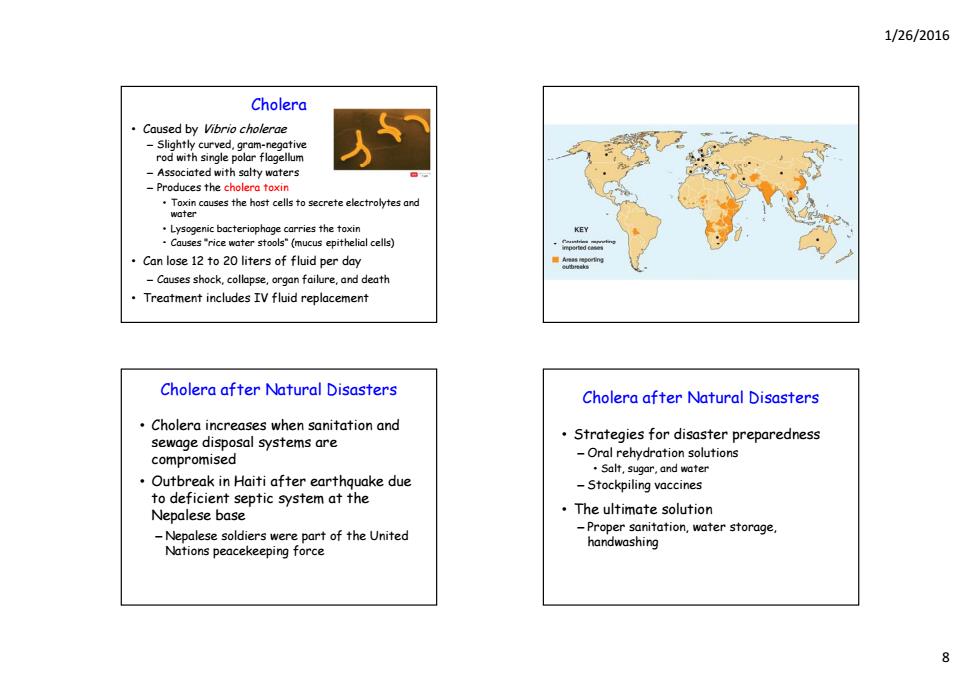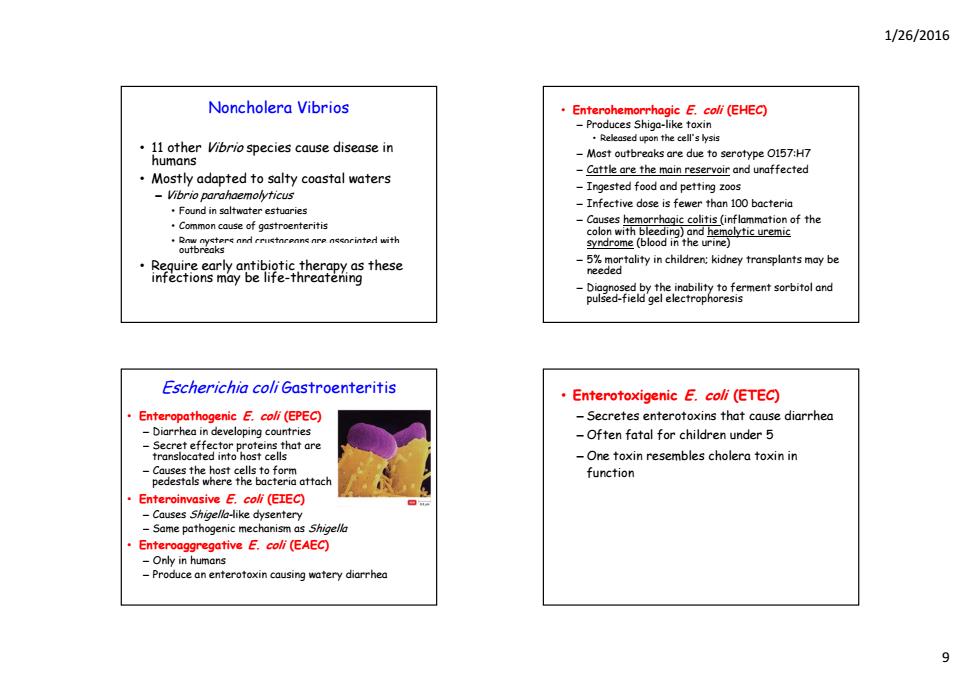
1/26/2016 Sequence of events in Shigellosis a typical outbreak of staphylococcal food poisoning Refrigeration is oge6 e恤cd best preventive methods okhaanga cells.thus avoiding immune defenses. nlegtosaoen rarely hrs.eaon Mucosal abscess Shigellosis(Bacillary Dysentery) Salmonellosis (Salmonella Gastroenteritis) Infection caused by the genus Shigella -Facultatively anaerabic:gram-negative:four species ·Salmonella enterica -Up to 20 bowel movements in one day -Gram-negative,facultative anaerobe, -12 h to 2 weeks incubation time nonendospore-forming rods Only spread from person to person:no animal -Normal inhabitant of the human intestinal tract reservoir -2000 serotypes .Produces the Shiga toxin (inhibits protein synthesis) Small infectious dose Invades intestinal mucosa and multiplies -Attaches to M cells,irvades,and spreads to other cells -Passes through M cells and enters the lymphatics Damage to the intestinal wall -Replicates in macrophages Can invade the bloodstream Incubation of 12 to 36 hours:fever,nausea, CDC estimates 450,000 cases annually:no vaccine yet pain and cramps,diarrhea Treated with fluoroguinolones and oral rehydration 6
1/26/2016 6 Sequence of events in a typical outbreak of staphylococcal food poisoning Refrigeration is best preventive methods Shigellosis (Bacillary Dysentery) • Infection caused by the genus Shigella – Facultatively anaerobic; gram-negative; four species – Up to 20 bowel movements in one day – 12 h to 2 weeks incubation time • Only spread from person to person; no animal reservoir • Produces the Shiga toxin (inhibits protein synthesis) • Small infectious dose – A h M ll i d d d h ll Attaches to M cells, invades, and spreads to other cells • Damage to the intestinal wall • Can invade the bloodstream • CDC estimates 450,000 cases annually; no vaccine yet • Treated with fluoroquinolones and oral rehydration Shigella Shigellosis M cell Epithelial cell lining intestinal tract Membrane ruffle Shigella enters an epithelial cell. Shigella multiplies inside the cell. Shigella invades neig gp hboring epithelial cells, thus avoiding immune defenses. An abscess forms as epithelial cells are killed by the infection. The bacteria rarely spread in the bloodstream. Mucosal abscess Salmonellosis (Salmonella Gastroenteritis) • Salmonella enterica – Gram-neg, , ative, facultative anaerobe, nonendospore-forming rods – Normal inhabitant of the human intestinal tract – 2000 serotypes • Invades intestinal mucosa and multiplies – Passes through M cells and enters the lymphatics – Replicates in macrophages • Incubation of 12 to 36 hours; fever, nausea, pain and cramps, diarrhea

1/26/2016 M cell Salmonellosis Typhoid Fever _Epithelial cell lining the Caused by Salmonella typhi intestinal tract Membrane ruffle 一Most virulent serotype ofmn恤 650 -Spread only by human feces Sa/monella enters an epithelial cell. -Rare in the United States today due to sanitation -Globally,21 million cases annually leading to tens of thousands of deaths Bacteria spread throughout the body in phagocytes -Releases organism into the bloodstream(spleen and liver) 68 the i High fever,headache,intestinal wall ulceration 1-3%of patients become chronic carriers -Harbor the organism in the gallbladder(Typhoid Mary) Lymph node Treated with chloramphenicol,quinolones,or Bloodstream cephalosporins Salmonellosis (Sa/mone/la Gastroenteritis) The incidence of salmonellosis and typhoid fever 30 1.4 million cases:shed from feces for 6 months ·4o0 deaths annually Associated with commercial chicken and egg 20 production -Hens are susceptible to infection -Bacteria survive in the albumin,which contains Typhoid fever -Caution for raw egg consumption -1 in 20,000 eggs are contaminated Bacterial source:intestines of many animals 440465258847076828940006“12 Diagnosed directly from the stool or by PCR Treatment with oral rehydration therapy
1/26/2016 7 Salmonella Salmonellosis Epithelial cell lining the intestinal tract M cell Membrane ruffle Salmonella enters an epithelial cell. Salmonella multiplies within a vesicle inside the cell. Salmonella multiplies in mucosal cells; th h fl here the inflammatory response l resu ts in diarrhea. Occasionally, the bacteria cross the epithelial cell membrane and enter the lymphatic system and bloodstream. Lymph node Bloodstream Salmonellosis (Salmonella Gastroenteritis) • 1.4 million cases; shed from feces for 6 months • 400 deaths annually • Associated with commercial chicken and egg production – Hens are susceptible to infection – Bacteria survive in the albumin, which contains antibacterials such as lysozyme and lactoferrin – Caution for raw egg p consumption – 1 in 20,000 eggs are contaminated • Bacterial source: intestines of many animals • Diagnosed directly from the stool or by PCR • Treatment with oral rehydration therapy Typhoid Fever • Caused by Salmonella typhi – Most virulent serotype of Salmonella – Spread only by human feces – R iare n th U it d St t the United States t d d t it ti today due to sanitation – Globally, 21 million cases annually leading to tens of thousands of deaths • Bacteria spread throughout the body in phagocytes – Releases organism into the bloodstream (spleen and liver) • Hi h f h d h i t ti l ll l ti High fever, headache, intestinal wall ulceration • 1–3% of patients become chronic carriers – Harbor the organism in the gallbladder (Typhoid Mary) • Treated with chloramphenicol, quinolones, or cephalosporins The incidence of salmonellosis and typhoid fever

1/26/2016 Cholera Caused by Vibrio cholerae -Slightly curved,gram-negative rod with single polar flagellum -Associated with salty waters -Produces the cholera toxin Toxin causes the host cells to secrete electrolytes and water Lysogenic bacteriophage carries the toxin .(mucus epithelial cell) Can lose 12 to 20 liters of fluid per day -Causes shock,collapse,organ failure,and death Treatment includes IV fluid replacement Cholera after Natural Disasters Cholera after Natural Disasters Cholera increases when sanitation and sewage disposal systems are Strategies for disaster preparedness compromised -Oral rehydration solutions ·Sat,sugar,and water 。 Outbreak in Haiti after earthquake due -Stockpiling vaccines to deficient septic system at the Nepalese base The ultimate solution -Nepalese soldiers were part of the United -Proper sanitation,water storage Nations peacekeeping force handwashing
1/26/2016 8 Cholera • Caused by Vibrio cholerae – Slightly curved, gram-negative rod with single polar flagellum – Associated with salty waters – Produces the cholera toxin • Toxin causes the host cells to secrete electrolytes and water • Lysogenic bacteriophage carries the toxin • Causes rice water stools (mucus "rice water stools“ (mucus-epithelial cells) • Can lose 12 to 20 liters of fluid per day – Causes shock, collapse, organ failure, and death • Treatment includes IV fluid replacement Cholera after Natural Disasters • Cholera increases when sanitation and sewag p ym e disposal systems are compromised • Outbreak in Haiti after earthquake due to deficient septic system at the Nepalese base – Nepalese soldiers were part of the United Nations peacekeeping force Cholera after Natural Disasters • Strategies for disaster preparedness – O l h d l Oral rehydration solutions • Salt, sugar, and water – Stockpiling vaccines • The ultimate solution – Proper sanitation water storage Proper sanitation, water storage, handwashing

1/26/2016 Noncholera Vibrios Enterohemorrhagic E.coli(EHEC) -Produces Shiga-like toxin Released upon the cell's lysis 11 other Vibrio species cause disease in -Most outbreaks are due to serotype 0157:H7 humans -Cattle are the main reservoir and unaffected Mostly adapted to salty coastal waters -Vibrio parahaemolyticus -Ingested food and petting zoos Found in saltwater estuaries -Infective dose is fewer than 100 bacteria Common cause of gastroenteritis ‘8GiRegrcadncnrmcmaorntodusth -Diagnosed by the inability to ferment sorbitol and pulsed-field gel electrophoresis Escherichia coli Gastroenteritis Enterotoxigenic E.coli(ETEC) Enteropathogenic E.coli(EPEC) -Secretes enterotoxins that cause diarrhea -Diarrhea in developing countries -Often fatal for children under 5 -One toxin resembles cholera toxin in function Enteroinvasive E.coli(EIEC) Causes Shige/la-like dysentery -Same pathogenic mechanism as Shigell Enteroaggregative E.coli(EAEC) -Only in humans -Produce an enterotoxin causing watery diarrhea
1/26/2016 9 Noncholera Vibrios • 11 other Vibrio species cause disease in humans • Mostly adapted to salty coastal waters – Vibrio parahaemolyticus • Found in saltwater estuaries • Common cause of gastroenteritis • Raw oysters and crustaceans are associated with outbreaks • Require early antibiotic therapy as these infections may be life-threatening Escherichia coli Gastroenteritis • Enteropathogenic E. coli (EPEC) – Diarrhea in developing countries – Secret effector proteins that are translocated into host cells – Causes the host cells to form pedestals where the bacteria attach • Enteroinvasive E. coli (EIEC) – Causes Shigella-like dysentery – Same pathogenic mechanism as Shigella • Enteroaggregative E. coli (EAEC) – Only in humans – Produce an enterotoxin causing watery diarrhea • Enterohemorrhagic E. coli (EHEC) – Produces Shiga-like toxin • Released upon the cell's lysis – Most outbreaks are due to serotype O157:H7 – Cattle are the main reservoir and unaffected – Ingested food and petting zoos – Infective dose is fewer than 100 bacteria – Causes hemorrhagic colitis (inflammation of the colon with bleeding) and hemolytic uremic syndrome (blood in the urine) – 5% mortality in children; kidney transplants may be needed – Diagnosed by the inability to ferment sorbitol and pulsed-field gel electrophoresis • Enterotoxigenic E. coli (ETEC) – Secretes enterotoxins that cause diarrhea – Often fatal for children under 5 – One toxin resembles cholera toxin in function